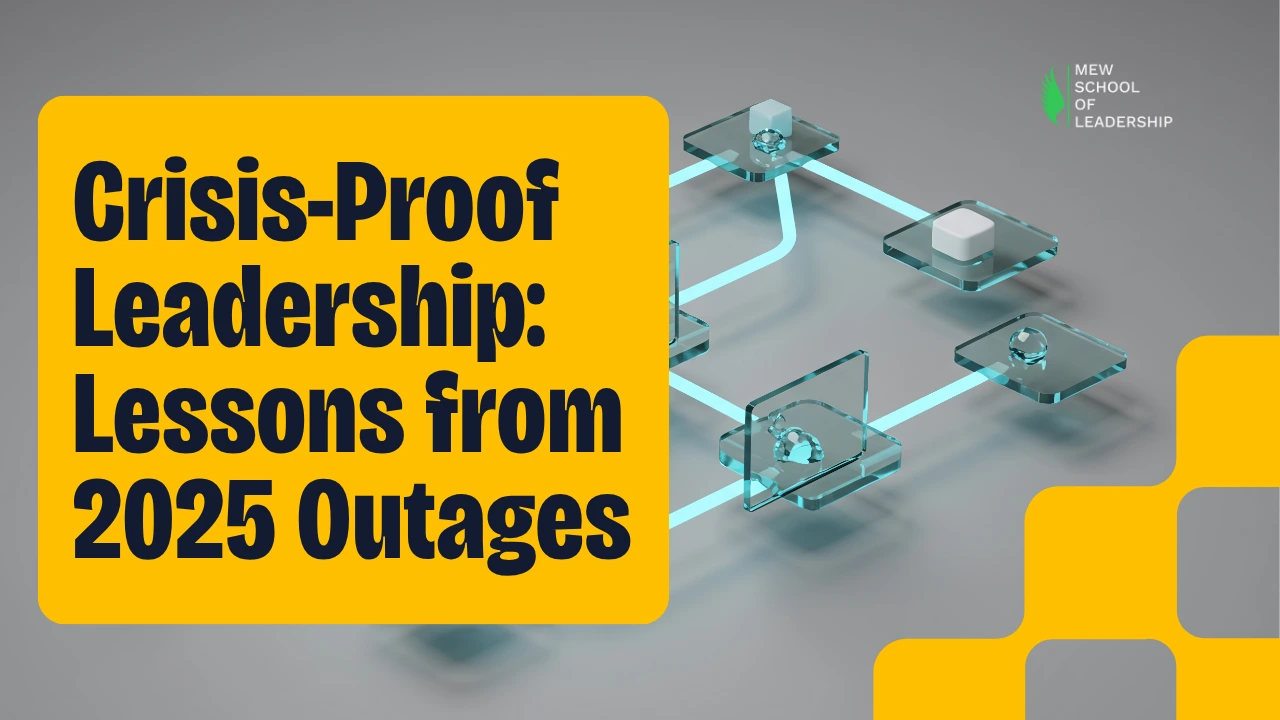
How do you lead when everything is offline?
When the 2025 cyberattacks paralyzed digital infrastructure worldwide, they exposed the limits of technical resilience. The true test was leadership's ability to navigate chaos, communicate with credibility, and return to analog basics.
The 2025 Global Cyber Outages served as a brutal stress test for every organization reliant on digital infrastructure—which today means every organization. These widespread attacks moved beyond simple data breaches; they were calculated strikes aimed at crippling operational technology (OT) and core systems, effectively making entire companies go dark.
The response was bifurcated: companies that had invested solely in technical defenses were paralyzed, while those led by "Crisis-Proof Leaders"—who prioritized human and procedural resilience—managed to sustain critical operations, maintain stakeholder trust, and recover faster. The lessons are clear: leadership in a digital crisis is not about IT expertise; it’s about mastering communication, composure, and critical human infrastructure.
The outages revealed four critical areas where traditional crisis management failed and where modern leadership must pivot:
In a digital crisis, the first casualty is often internal morale. The overwhelming sense of helplessness when systems fail can lead to organizational paralysis. Leaders who maintained control projected calm and focused on defining a clear internal objective—"We are safe, and we have a path."
The Lesson: Prioritize Psychological Safety. Crisis-proof leaders immediately moved teams off compromised channels (e.g., email) to secure, analog backups (e.g., physical whiteboards, secure phone trees). The first communication was focused not on the cause, but on employee safety and assigning non-digital, critical tasks.
Actionable Takeaway: Implement "Blackout Day" drills where the organization practices executing mission-critical functions without access to the internet, email, or core servers. This builds muscle memory for human-powered processes.
The instinct in any crisis is to rush out a statement, but the 2025 events proved that inaccurate or premature communication is toxic to trust. Organizations that tried to downplay the scope of the attacks were immediately exposed by media and industry peers, leading to a long-term credibility gap.
The Lesson: Establish a Single Source of Truth. Crisis-proof leaders focused their external messaging on what they knew for sure and what they were doing next, not on speculation about the perpetrators or the full extent of the damage. They communicated frequently—even if the update was "We are still assessing the full impact, but our recovery team is executing Step X."
Actionable Takeaway: Designate and train a Crisis Communication Lead whose sole function is external messaging. Pre-write templates for "Confirmed Outage," "Investigation in Progress," and "Phased Recovery," ready to be filled with verifiable facts only.
When ERP systems fail, supply chains stop. Leaders who had previously established flexible, manual workarounds were the ones who minimized downtime. They understood that resilience is about process redundancy, not just data redundancy.
The Lesson: Empower the Front Line to Improvise. In the outages, local managers who could bypass the disabled digital system and use simple, paper-based forms (e.g., for inventory, customer orders, or delivery dispatch) saved operations. This ability stems from leadership that had previously trained employees on the manual fundamentals of their jobs.
Case Example: A global logistics company was able to partially continue shipping by reverting to manual customs forms and using satellite phones, thanks to pre-outage training that focused on the foundational, non-digital flow of its supply chain.
Before 2025, many boards viewed cybersecurity spending as a necessary defense cost. After the outages, the perspective shifted: Digital Resilience is a competitive differentiator. Investors and stakeholders now demand proof of not only how an organization prevents attacks, but how quickly it can operate and recover when an attack succeeds.
The Lesson: Integrate Cyber Risk into Business Strategy. Crisis-proof leaders treat cyber risk as a core business continuity risk, placing it on the executive committee's agenda alongside financial and geopolitical risk. Recovery plans are not just IT documents; they are Board-approved Business Continuity Plans (BCPs).
Actionable Takeaway: Shift your organization's focus from a purely Preventative Model (trying to stop all attacks) to a Resilience Model that prioritizes detection, containment, and rapid, functional recovery.
The 2025 Global Cyber Outages redefined crisis leadership. The most resilient organizations were those led by individuals who understood that when technology fails, human systems, communication protocols, and a calm demeanor are the ultimate operational safeguards.
Leading in a cyber crisis means leading without the tools you rely on every day. It demands a prepared mind, an honest voice, and the courage to trust your teams to execute basic, analog functions when the digital world goes dark.
STOP: Assuming technology will always protect you.
START: Training teams on manual, paper-based, "worst-case scenario" business procedures.
PRIORITIZE: Composure over speed in initial communications. Credibility is your most valuable asset during a crisis.
MANDATE: That cyber resilience is viewed as a Business Continuity mandate, not just an IT problem.
Stay up to date with the latest news, announcements, and articles.